I'm fairly sure I don't really need to sell anybody on Re-Animator. If you're into horror films at all, you've most likely seen it, and if not, you've at least heard of it and quite possibly plan on watching it. If that's the case, what are you waiting for? Get to it.
It has this:
this:
this:
this thing here:
this:
some of this:
one of these:
this too:
a little of this:
these guys here:
this:
and this:
That pretty much covers the basics. Any questions?
Director Stuart Gordon was operating The Organic Theater Company in Chicago, Illinois, when he decided to try his hand at making a movie. Gordon wanted to do something with the Frankenstein myth, but a friend turned him on to the writings of H.P. Lovecraft, specifically the short story "Herbert West-Reanimator." Once this concept was decided on, Gordon started to develop the project as a possible half-hour long anthology TV series, but none of the networks were interested in half hour shows (they preferred hour long), nor were they interested in anything horror themed.
Gordon was then introduced to first time producer Brian Yuzna, who had some personal money to spend at the time, as well as the means to raise more funds. More importantly, Yuzna was a fan of horror films and was an enthusiastic producer. Dropping the idea to make it an anthology series, they focused on making a feature length movie instead. The final screenplay is credited to Dennis Paoli, William J. Norris (who was involved more with the TV series proposal), and Stuart Gordon himself, and it makes many deviations from the source story, such as modernizing the setting and adding the characters of Dan, Megan, and Dr. Hill.
Shot in 3 weeks in Los Angeles, Re-Animator would feature a great cast that was more than willing to get gooey and gross with the fantastic special effects work. The effects were completely practical (all done on set), utilizing gallons of fake blood and animal guts. The most complicated effects work was done with the severed, re-animated head of Dr. Hill, which was accomplished by using a combination of 7 different techniques to sustain the macabre illusion. The simplest effect, that of the glowing re-animate serum, would also end up becoming one of the more iconic images from the film. The sickly, green goo was made from the same solution found most commonly in glow-sticks and its use in Re-Animator was the first time it was seen on screen in a motion picture.
The film is energetically in-your-face and over the top, bringing black, gallows humor in combination with the graphic special effects. The entire scene with Herbert and Dan chasing Rufus the cat in the basement is both tension filled and a laugh riot. It's perfectly punctuated by Herbert pulling a "gotcha" on Dan after he hurls the cat at the wall. The balance of horror and humor in the Re-Animator is comparable to that of other horror/comedies such as House (1986), Evil Dead 2 (1987) and Peter Jackson's Bad Taste (1987) and Dead Alive (1992).
Released in October of 1985, Re-Animator would be met by an enthusiastic public and would even win the critics award at the Cannes film festival that year. The film would do good financial business and would garner positive reviews from critics Roger Ebert and Pauline Kael. This feat is even more impressive as the film wasn't submitted to the MPAA and was released 'unrated,' which severely limited how and where the film could be marketed. The film would later find new life (so to speak) on the home video market where it would cultivate its cult following.
Stuart Gordon would go on to sign a three picture deal with executive producer Charles Band and Empire Pictures, moving to Rome to direct From Beyond (1986, another Lovecraft production), Dolls (1987), and Robot Jox (1989). He would work again with the same cast and crew on multiple projects. In recent years, Gordon has returned to directing productions on the stage; his last film was the based-on-a-horrible-true-story Stuck (2007). One of Stuart Gordon's most interesting film credits (given the rest of his body of work) is a story credit (along with Brian Yuzna) for the family adventure film Honey, I Shrunk the Kids (1989).
Brian Yuzna would produce Stuart Gordon's next two movies and would start directing films himself with the amazing special effects spectacle Society (1989). He would also direct both Re-Animator sequels, the enthusiastically weird Bride of Re-Animator (1989) and the not so good Beyond Re-Animator (2003). Brian Yuzna would reteam with Stuart Gordon in 2001, producing his adaptation of Lovecraft's Dagon.
1985 was a busy year for zombie movies, also seeing the release of George Romero's Day of the Dead and Dan O'Bannon's Return of the Living Dead. Both of those films would see greater financial success, but Re-Animator is a much more entertaining and enjoyable film when compared to the rather bleak (but admittedly still entertaining) Day of the Dead or the rather stupid ROTLD (for my money, I've always preferred Part III (1993) of that series, which happens to be directed by Brian Yuzna).
 |
| "Mr. West, I suggest you get yourself a pen!" |
David Gale plays a great villain and has a classic screen presence about him, a more gothic look, like he belongs in a Frankenstein film or something, which might actually be why his casting is so apt. A subplot was cut out of the finished film depicting Dr. Hill as having hypnotic powers, unnecessarily explaining his control over the zombies later in the film. David Gale would reprise his role as Dr. Hill in the sequel, Bride of Re-Animator, apparently in spite of his character's condition at the end of the first film. His promising film career would be cut short by his untimely death in 1991.
Barbara Crampton was very brave to be in this film, considering what her character has to go through later in the movie. She's really great in the role as Megan, giving her sincerity and confidence, and not just playing her as a terrified, helpless girl (although she does have a great scream). Her scenes with Bruce Abbott really ground the film and give it a sense of normalcy amongst all the chaos and these weird, eccentric characters. Kudos to Abbott for playing an excellent everyman and really holding the movie together.
The art direction was done by the great Robert A. Burns (Texas Chainsaw Massacre, Mausoleum) and I'd like to think it was his choice to hang up that big Talking Heads poster on the wall behind Dan's bed during all the love making scenes.
The writer of the film Dennis Paoli would also write Gordon's From Beyond, The Pit and the Pendulum (1991), Castle Freak (1995), and both of his Masters of Horror entries. He would also pen Brian Yuzna's dental horror/Corbin Bernsen showcase The Dentist (1996) and its 1998 sequel. At his day job, Paoli is a professor of gothic literature at Hunter College in New York City.
The iconic theme song by Richard Band (Charlie Band's brother) borrows motifs from Bernard Herrmann's score for Psycho (1960), which has caused him to be accused of being a hack and/or a plagiarist (by some). I think by borrowing from a film score as famous as Psycho it gives the music a playfulness that alerts the audience that, yes, you are watching a horror film, and yes it's okay to laugh and have fun. The opening animated credits add to this feeling, as if you are getting ready to watch some sort of demented cartoon.
The cinematographer Mac Ahlberg was an Empire Pictures vet, also shooting the low budgeted (but entertaining) Ghoulies, Trancers (both 1985), and Eliminators (1986). He helped educate Gordon on the craft of filmmaking during the production of Re-Animator, sometimes through gentle arguments and heated disagreements. They apparently forged a strong working relationship, as they'd work together on another five films.
Ahlberg is quoted as saying that David Bowie has told him that Re-Animator is his favorite movie.
If that's not an endorsement, I don't know what is.

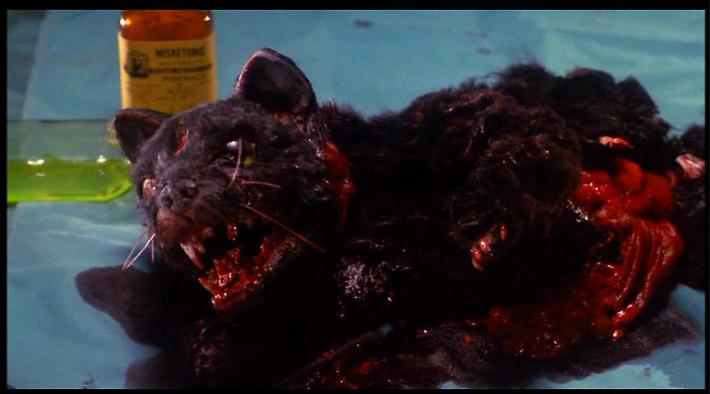




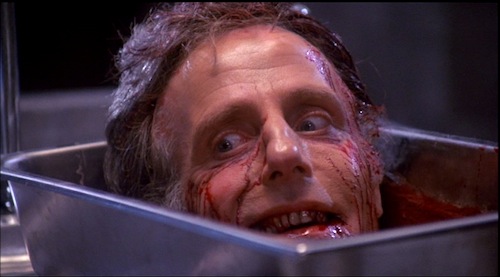






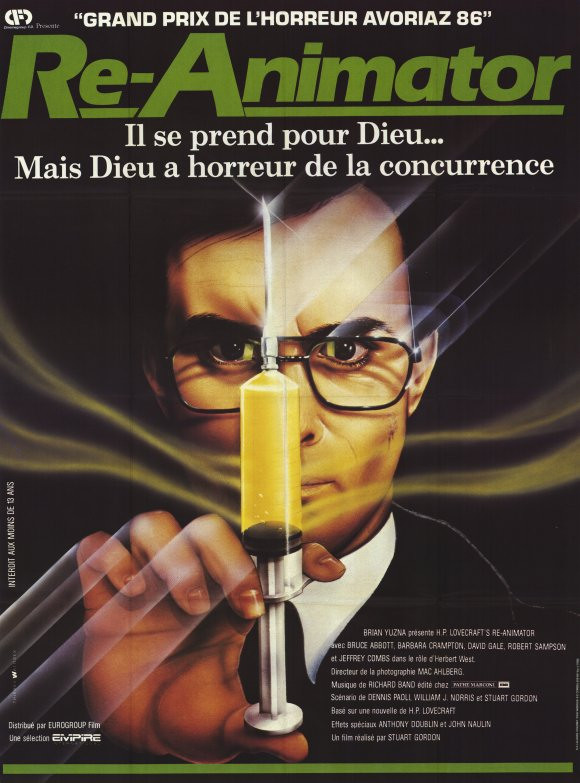


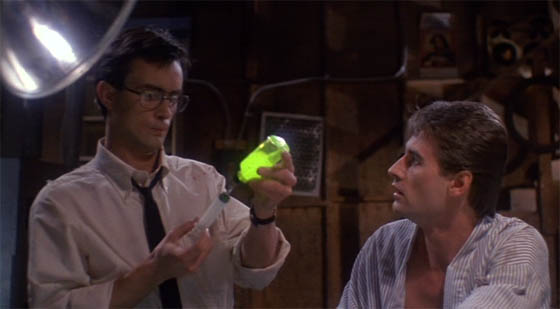

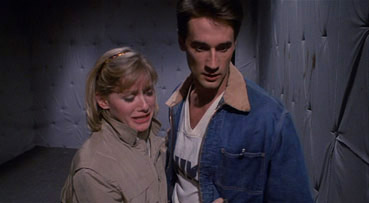




No comments:
Post a Comment